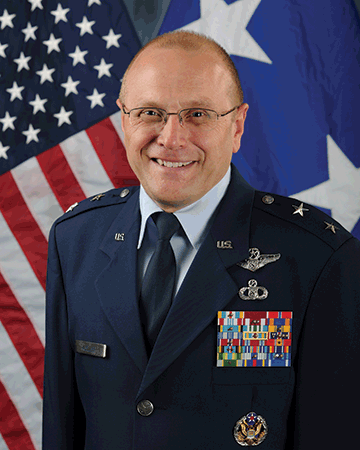The 2017 CEOs Who 'Get It'


Maj. Gen. Andrew M. Mueller
Air Force Chief of Safety
Headquarters U.S. Air Force
Washington, DC
As Air Force Chief of Safety, Maj. Gen. Andrew Mueller also serves as commander of the Air Force Safety Center, located at Kirtland Air Force Base, in Albuquerque, NM. The center’s staff has approximately 150 military members, federal civilian employees and contractors who develop, implement, execute and evaluate all Air Force aviation, occupational, weapons, space and system mishap prevention, and nuclear surety programs and policy to preserve Air Force combat capability.
Why is safety a core value in the U.S. Air Force?
Simply put, a strong safety mindset ensures the ability of our Air Force to accomplish the mission. Sound, proactive safety practices safeguard the Airmen and protect the resources that comprise the Air Force. Safety is inherent in everything we do to preserve the combat readiness of our Air Force.
Describe your personal journey to becoming a safety leader who “gets it.”
In many respects, my foundation in safety was built from a safety culture that has existed in the Air Force for 70 years. Watching and learning sound safety practices from experienced aviators at the squadron level instilled in me respect for the hazards associated with aviation and a strong confidence in the procedures and equipment to protect myself and my crew from these hazards. I learned early on that aviation is terribly unforgiving and even the smallest of mistakes can translate into fatal or catastrophic mishaps. Unfortunately, sometimes these lessons came with the price of losing a fellow Airman, something that really strengthens the goal of not letting anyone repeat these fatal mistakes. This early experience instilled in me the importance of a heathy organizational safety culture and has enabled me to become an informed leader in the arena of safety. As I teach and lead the safety programs in the Air Force today, I do so with the goal of not letting Airmen repeat the mistakes that led to mishaps in the past and sustaining the safety culture that fosters open communication about safety with the goal of preventing mishaps across all disciplines in the Air Force.
What is the biggest obstacle to safety in the U.S. Air Force, and how do you work to overcome it?
With the high demand for Air Force capabilities worldwide, talented, skilled and enthusiastic Airmen face the challenge of sustaining operational requirements with limited resources. This can make operations susceptible to shortcuts and workarounds – all done with the good intent of meeting the operational demands, but exposing the operation to the very hazards the process or procedure not being followed was designed to prevent. Non-compliance or worse, complacency, needlessly accepts additional risk. If this non-compliance or complacency becomes habit, the individual or organization has now normalized a deviation, making a process, which is actually wrong, appear as normal.
Overcoming this “normalization of a deviation” requires every Airman to accept personal responsibility for the mission and their safety while accomplishing the mission. Within this responsibility is the requirement to use real-time risk management skills, asking “What are the potential consequences of taking shortcuts or using workarounds?” If the potential consequence seems too high, Airmen need to report the problem to ensure risk decisions are made at the right level and they should always take the time to do the task right. At times, it is difficult to get people to accept personal responsibility for their own safety. Non-compliance and poor risk management in particular continue to rate high as contributing factors in mishaps.
How do you instill a sense of safety in employees on an ongoing basis?
Safety awareness, education and training starts when an Airman enters the Air Force and continues throughout their career. Key to this process is direct involvement and engagement of leaders at every level. This is essential to a successful Air Force safety program.
A proactive safety culture is maintained through leaders who are committed to providing the requisite resources, training and tools to enable these Airmen to operate with sound safety practices. In addition, these leaders emphasize personal accountability to ensure every Airman respects the known hazards with service in the military and, equally important, respects the processes and procedures in place to protect them from those hazards.
An aggressive strategy to promote and educate every member of the Air Force on safety helps ensure employee participation and buy-in within the safety program. Employees are entitled to question processes and procedures that may present an unsafe work condition, creating a confidence that their personal safety matters. It also ensures timely, relevant safety information reaches the entire organization. There is no one solution to delivering safety information so this is a constant effort through a variety of means. The message must be fresh and relevant to capture the attention of people across the organization.
As the Chief of Safety for the Air Force, I see myself as an enabler of activities to sustain a safety-conscious culture across the Air Force. If we get it right, 99 percent of our activities and efforts in safety will be before a mishap ever happens, giving Airmen the ability to routinely operate in a high-risk environment with a high degree of confidence in their safety.
How does your organization measure safety? What are the leading indicators that show you how safe your organization is, and where do you see room for improvement?
The temptation is to measure safety effectiveness through mishaps rates. But we can’t wait for mishaps to measure safety. Therefore, the Air Force has organized the proactive safety activities under four pillars of a Safety Management System. These pillars allow the organization to measure what is being done proactively – before mishaps – giving leaders confidence in knowing the unit is safe.
The four pillars are policy, assurance, risk management and promotion/training/education.
Policy starts with the Air Force Chief of Staff endorsing the Air Force safety program, which is crafted and codified by subordinate levels including the Air Force Safety Center. It must be comprehensive and current in nature to define the program construct and execution process. A simple metric here is measuring the comprehensiveness and currency of our policies.
Assurance is oversight and validation that the safety program conformance and performance are acceptable. Evaluations, assessments and inspections are activities we use to measure safety.
In addition, all accidents, or mishaps, are investigated and reported to include a review process to validate the recommendations are on target to prevent similar mishaps.
Surveys provide extremely useful insight to the safety culture and attitudes of an organization. Our safety culture surveys give commanders findings and recommendations that have direct application to the safety climate, culture, leadership and supervision of their organizations. Safety culture survey results indicate that mishap rates are lower when workers feel more positive about their work environment and are more productive, which then leads to higher morale, further increasing productivity and strengthening a safe and healthy culture across the Air Force.
Risk management is the heart of a safety program. It requires trained personnel at all levels to be able to identify and manage risk and have formal processes and procedures to this end. It involves a constant review of areas where leaders knowingly accept higher than normal risk due to the nature of our military mission. Looking at the number of authorized waivers to established policies is a telling metric in this area.
Finally, promoting safety through education and training is the most important proactive safety measure of the Air Force SMS. Knowing our level of employee participation in safety training programs or how many employee hazard reports are received are useful indicators for safety.
In the Air Force SMS, we focus considerable efforts on proactive safety – identifying the mishap precursors and indicators to prevent the next mishap. Research and analyses show us that near misses and non-standard behavior are leading indicators and point us to the areas where we need to focus more attention. We look at how to detect those often-hidden leading indicators of mishaps, and how we can leverage technology and new thinking to proactively detect otherwise masked hazards. Hard data provided by our proactive safety reporting programs allow us to find those outliers in behavior, near misses and trends and fix them before they become our next serious mishap.
What role does off-the-job safety play in your organization’s overall safety program? What types of off-the-job safety and health programs does your organization offer to employees?
Keeping Airmen and their families safe off duty is an integral part of the Air Force Safety program because whether their injury or death occurs on or off duty, we have lost their contributions to our mission. Sadly, each year the Air Force loses the preponderance of our Airmen during off-duty activities – most through motor vehicle accidents on local streets and highways.
The goal of our off-duty safety program is to translate the sound safety practices learned on duty or through on-duty activities to off-duty activities as well. At times, I am surprised by the level of risk an Airman is willing to accept during off-duty recreational activities, a level of risk that would be unacceptable while on duty.
We offer driver training and motorcycle operator training courses to improve the driving skills of our younger Airmen. We sponsor recreational activities and facilities through the local Morale, Welfare and Recreation organization to provide Airmen and their dependents a structured umbrella to engage in high-risk activities such as general aviation flying, scuba diving, indoor/outdoor sports. We use these occasions to underscore the importance of a good work-life balance. It’s a powerful opportunity to strengthen morale of our professionals as well as drive home to family members the same safety messages we give our workforce. We want all Airmen and their families to know safety as a habit and to make safety a habit for life.
Post a comment to this article
Safety+Health welcomes comments that promote respectful dialogue. Please stay on topic. Comments that contain personal attacks, profanity or abusive language – or those aggressively promoting products or services – will be removed. We reserve the right to determine which comments violate our comment policy. (Anonymous comments are welcome; merely skip the “name” field in the comment box. An email address is required but will not be included with your comment.)


